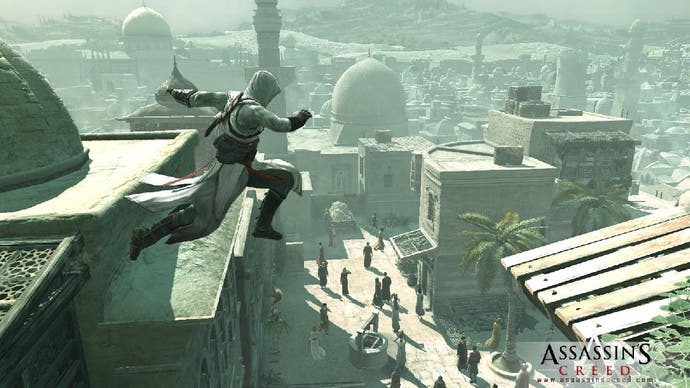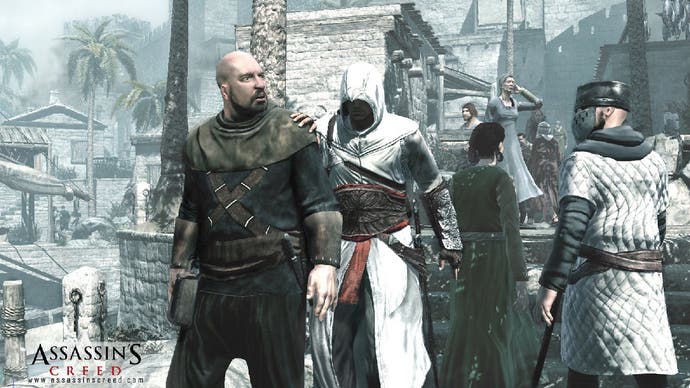Assassin's Creed: A forumite in Montreal!
A forum-eye view of Ubi's next big thing...
When Ubisoft asked us if we'd like to send one of our forumites to Montreal to play Assassin's Creed, we said no, we'd like to send ourselves instead. When they told us to sod off, we had a sulk for a bit and then elected someone - in this case, the young and dashing Richard Horne. What follows is his untouched impressions of the game based on... well, we'll let him explain. We also inserted lots of errors and typos so he doesn't put us out of a job. Good day.
As a cynical and jaded gamer, I appreciate that were the proverbial boot on the other foot, I'd not necessarily place too much faith or confidence in the glowing impressions of a game written by someone who'd just been flown to Montreal (economy class in case you're wondering) and had been very much looked after for three days by the game's developer. However, those of you that don't know me should be reassured by the fact that I'm a straight talking Yorkshireman who's not afraid to tell it like it is.
But just before I delve into describing the intricacies of the game, I'd just like to spend a few moments outlining some of the details described in the exclusive presentation given to us by Assassin's Creed's producer Jade Raymond and Creative Director Patrice Desilets.
Ubisoft began work on Assassin's Creed in 2004 after the completion of the third Prince of Persia title and from the very beginning, even before the first piece of concept art was drawn up, Ubisoft's mandate was to clearly redefine the action adventure genre and present gamers with a level of immersion never before seen in a game. Patrice and Jade described how in order to achieve this, throughout development of the game, it was imperative to do away with traditional gaming conventions such as floating energy top-ups, invisible boundaries, NPCs that don't react to the actions of the main character and more importantly the lack of freedom to explore every single nook and cranny of a game's world. I'll come back to why this is important later.

My preview of the game began in Masyaf, which is the assassin stronghold and home to Altair (pronounced Al-tie-ear) who is the game's main protagonist. Masyaf is set in a vast area of countryside called The Kingdom which is located centrally between the game's three main towns - Acre, Jerusalem and Damascus. The Kingdom acts as a sort of central hub area, similar to Hyrule Field in Zelda if you will, and can be traversed on foot or on Altair's trusty steed which officially beats both Shadow of the Colossus and Zelda by easily being the best videogame representation of a horse. In the preview build I played, I was able to freely explore both Acre and Jerusalem. However, I got so suckered in to my time with Acre that I didn't actually have the time to visit Jerusalem - in fact our time with the game full stop was unfortunately cut short by an impatient French coach driver.
The main bulk of the game focuses on successfully completing the assassinations of various 'boss' characters that are key figures in the game's universe and narrative. However, in order to gather the intel required to be able to attempt these assassinations, various side quests must first be completed. These range from pick-pocket missions to stealthy assassinations of some of the lesser characters, to interrogations (which usually involve a fist fight), to the rescuing of citizens from various sticky situations to scouting objectives which require you to scale the summit of a particularly tall building within the town in order to successfully "synchronise" yourself with the world.
The reason I've put the word synchronise in air quotes is that while for the main part the game seems fairly straightforward in terms of its medieval narrative, there's also some underlying futuristic plot branch that's yet to be revealed in its entirety. You'll have noticed in the gameplay videos, I'm sure, the various digital effects that appear over enemies and characters within the game. There are also references to memory rewinds and fast forwards, the aforementioned synchronisations with the game world, error messages that appear when cut-scenes start and lots of other seemingly out of place events that hint at some sort of contemporary link to what's happening within the game. Ubisoft would not elaborate on this but did assure me that everything is explained and becomes clear and logical within the first few minutes of the full game.

Assassin's Creed is, if you didn't already know, a third-person action adventure similar at first glance to Prince of Persia. Some would suggest, and they'd no doubt have a fair point, that Assassin's Creed is actually a logical extension of that franchise as there are undoubtedly many similarities - mainly in how the characters move. However, while PoP funneled you down straightforward, linear tunnels, the world of Assassin's Creed is a much more open and free-roaming place where it's possible to play the game exactly how you choose to instead of being dictated to by the tight, narrow level design. In fact the assassinations required to drive the story forward can apparently be completed in any order, providing you've uncovered the necessary intel beforehand.
For me personally, Altair also happens to be one of the most well-designed videogame characters in recent memory. But bear with me on this, for I'm already anticipating your groans of "but he's just another hoodie-wearing emo bastard!" Altair's hood and cape were intentionally designed so that the shadow he casts (due to the pointed peak on his hood and the split down the back of his cape) closely resembles an eagle. Which while looking fantastic in action, is also a brilliant metaphor for the grace with which Altair floats around the world of Assassin's Creed, as well as the speed and lethality with which he attacks his prey. Jade also mentioned that the final design they chose for Altair was actually the very first concept they created but was then never surpassed by any of the designs that followed.
There's a general rule in Assassin's Creed (which I'll now refer to as AC as I'm sick of typing the word ass) that dictates that any ledge, stone or object that sticks out by more than 10cm can be used by Altair as a foot or hand grab in order to climb up any of the game's architecture. And in actual practice this system works brilliantly well. It's deliciously satisfying planning out the many different routes Altair can take to climb to his intended destination. And much like Crackdown, which incidentally parts of the game very much reminded me of, it was fantastic fun just to pick a building in the distance and work out the best way of getting to the top of it. Again like I experienced after playing Crackdown, later on that evening as we were wandering around Montreal I found myself looking at real life buildings contemplating which edges or windows I could grab a hold of, and which ledges were perfect for propelling myself to the top. The graphics and draw distance in the game are quite staggering and that new next-gen feature of "if you can see it you can scale it" was more than evident.

I also noticed very early on that the animation of Altair is quite simply second to none. I especially found myself hugely impressed by the grace and speed at which he moves around the levels. The transitions between the many different types of actions are simply flawless and a staggering achievement when you consider the multitude and complexity of accomplishing real-time and very often random changes in direction and motion.
While we're on the topic of visuals, I'd noticed in preview videos before my trip that the game had some serious v-synch issues that made the game tear as bad as, if not worse than, God of War 2 and this was top of my list of pertinent questions to ask Ubisoft while I was there. However, before I'd even played the game and completely unprompted, Patrice went to great pains to say that the game had gone through a massive optimisation process recently which had removed tearing in its entirety. Now I realise that for most of you this is very much a non-issue, but Ubisoft has garnered a bad reputation for itself in this department in recent games and I know a lot of people that will breathe a huge sigh of relief as I confirm that in my time with the game I did not experience a single screen tear. I confirmed this with some of the other people playing the game and they all backed up my claims. However, there was mention from one person of a single slight occurrence of tearing during an in engine cut-scene as the camera closed in on one of the main characters.







